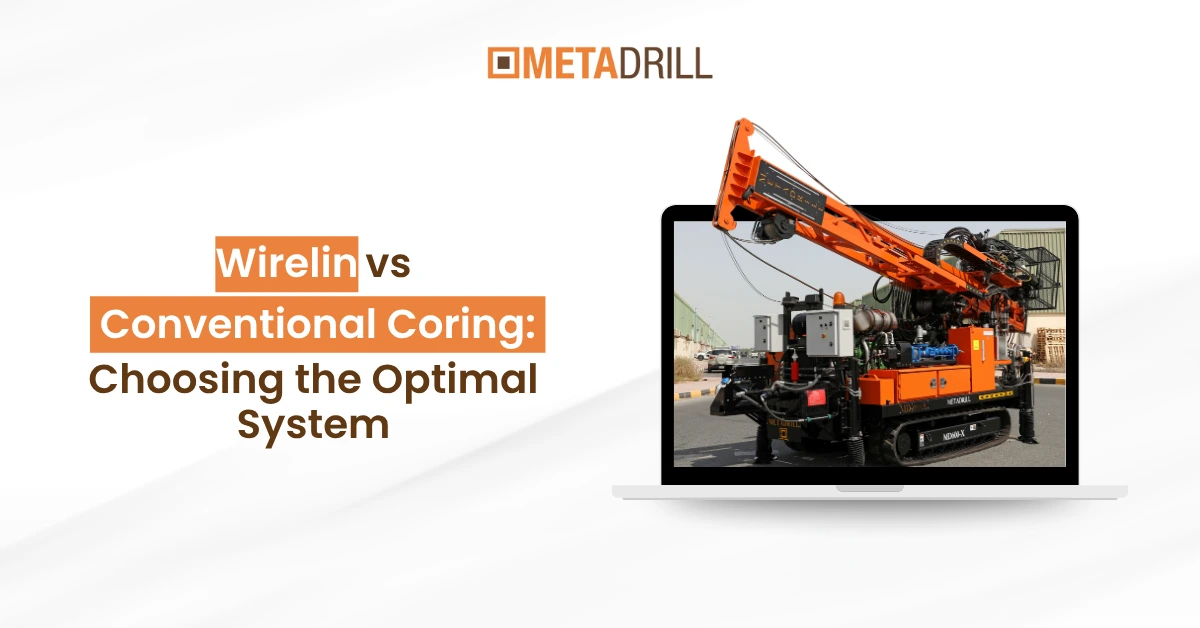
In geotechnical drilling, the right coring method and right drilling can determine a project's success. MetaDrill says picking the right drilling rig is crucial for success. Choosing wireline or conventional coring depends on efficiency, cost, and safety.
As per industry reports on geotechnical drilling 65% of deep geotechnical projects now use wireline coring because it is fast and requires less labor. However, conventional coring is still important when you need the best sample, particularly in shallow and moderate depths. While both methods give good core samples for studying rock, planning foundations, or exploring minerals, the way they work is different.
Engineers and geotechnical consultants must know these differences because incorrect coring decisions can increase project time by 20–30% and incur additional costs.
In Virginia, drilling studies can go up to 500 meters, and the choice of coring system directly affects project outcomes. Companies with advanced drill rigs now work faster and get better samples. Ultimately, knowing the benefits and limits of each coring system helps managers make better and cost-effective choices.
Conventional Coring: Reliable but Slower
Conventional coring has been the main method in geotechnical drilling for years. It works by turning a long drill pipe to take rock or soil samples. This coring is good when the sample must stay intact because it protects the sample. Studies show that conventional coring can recover up to 98% of the core in hard rock, making it ideal for studying soil, rock, and foundations.
However, conventional coring can take a lot of work. Each time a sample is collected, the whole drill pipe often has to be pulled out of the hole. This can delay the project. For big projects, each sample may take extra hours, especially when drilling deeper than 200 meters. Despite these problems, conventional coring is still widely used by companies that value sample quality over speed.
Wireline Coring: Faster and Safer
Wireline coring has changed geotechnical drilling because it allows core samples to be taken without pulling out the whole drill pipe. This method uses a special inner tube and wireline system. It is much faster than conventional coring. According to Geotechnical Engineering journal, wireline coring can save 40–50% of the time it usually takes to pull the drill pipe, which reduces costs and speeds up deep drilling projects.
Wireline coring is very helpful for deep projects. For example, in Virginia, spud barge drilling can go over 300 meters. Wireline coring is faster and easier on all machines, including small ones. It also improves safety and reduces the risk of accidents at the site.
Factors to Think About When Choosing a Coring Method
Picking the right coring system depends on:
Depth of Drilling: Shallow projects may still use conventional coring, while deep projects use wireline.
Project Budget: Wireline machines can cost more initially, but they often save money in the long run.
Core Quality: Both methods give good samples, but conventional coring keeps the sample complete.
Safety and Workload: Wireline coring reduces work and the risk of heavy drill pipes.
Equipment Availability: Having the right drill machines, for sale or rent, helps us finish the project on time.
By thinking about these points, managers can avoid delays and get the correct data for design and analysis.
The Role of Modern Geotechnical Drilling Equipment
Modern drill rigs are very important for good coring work. Companies like MetaDrill provide rigs that work for both conventional and wireline coring. These rigs come with reliable tools and can handle different types of soil and rock.
There are small compact rigs for tight spaces and bigger rigs for large projects. Modern rigs make drilling faster while keeping the sample quality high.
Companies also offer rigs for rent or sell used geotechnical rigs. This allows smaller projects to get good drilling machines without spending too much money. With the right rig, projects get better sample recovery, less downtime, and safer work conditions.
You can also check: Rig Health in Real Time: The Sensors, You Didn’t Know You Needed
Conclusion
Picking Wireline or Conventional Coring depends on the project, its depth, and budget. Use conventional coring for shallow projects, and wireline for faster and safer drilling.
MetaDrill provides modern rigs and reliable geotechnical drilling services. Their machines help collect accurate samples and complete projects efficiently. Working with a trusted drilling company saves time, reduces costs, and gives accurate subsurface data for projects.
Question to the public:
Not sure whether to use wireline or conventional coring? MetaDrill explains both methods simply and helps you choose the best system for your project.